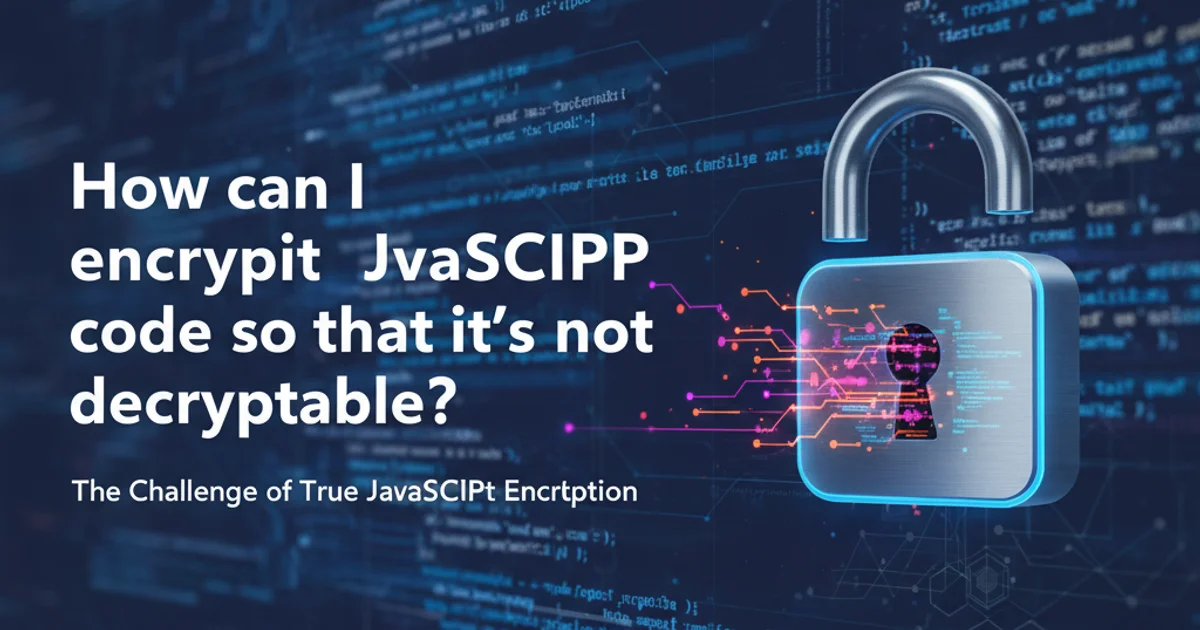How can I encrypt JavaScript code so that it's not decryptable?
Categories:
The Illusion of Undecryptable JavaScript: Understanding Obfuscation vs. Encryption

Explore why true, undecryptable encryption of client-side JavaScript is a myth and what techniques developers use to protect their code from casual inspection.
A common question among JavaScript developers is how to 'encrypt' their client-side code to prevent others from reading or reverse-engineering it. The short answer is: you can't truly encrypt JavaScript in a way that makes it undecryptable while still allowing the browser to execute it. This article will delve into why this is the case, explain the difference between encryption and obfuscation, and discuss practical strategies for protecting your intellectual property in a web environment.
Why True Encryption is Impossible for Client-Side JavaScript
For a web browser to execute JavaScript code, it must be able to read and interpret it. This fundamental requirement means that at some point, the code must exist in an unencrypted, readable form on the client's machine. If you were to encrypt your JavaScript, the browser would need a key to decrypt it. Where would this key come from? If the key is embedded in the client-side application itself, then anyone with access to the code can find the key and decrypt the JavaScript. This creates a circular dependency where the mechanism to decrypt is itself exposed.
flowchart TD
A[Server] --> B[Encrypted JS Sent to Client]
B --> C{Client Browser Needs to Execute JS}
C --> D[Browser Needs Decryption Key]
D --> E{Where is the Key?}
E --> F[Key Embedded in Client-Side Code]
F --> G[Attacker Extracts Key]
G --> H[Attacker Decrypts JS]
H --> I[JS is Readable]
C --> J[Browser Executes Decrypted JS]
style F fill:#f9f,stroke:#333,stroke-width:2px
style G fill:#f9f,stroke:#333,stroke-width:2px
style H fill:#f9f,stroke:#333,stroke-width:2px
style I fill:#f9f,stroke:#333,stroke-width:2pxThe inherent flaw in client-side JavaScript encryption
Obfuscation: The Practical Alternative
Since true encryption isn't feasible, the industry standard for protecting client-side JavaScript is obfuscation. Obfuscation transforms your code into a functionally equivalent but much harder-to-read version. It doesn't encrypt the code, but rather makes it deliberately complex and confusing, deterring casual inspection and making reverse-engineering significantly more time-consuming and difficult. It's a deterrent, not an impenetrable shield.
Common obfuscation techniques include:
1. Minification
Removes unnecessary characters like whitespace, comments, and shortens variable/function names. This is primarily for performance but also adds a basic level of obfuscation.
2. Renaming Identifiers
Changes meaningful variable, function, and class names into short, meaningless ones (e.g., calculateTotal becomes a).
3. String Concealment
Encodes or splits string literals to prevent easy searching and understanding of their purpose.
4. Control Flow Flattening
Transforms the code's logical structure into a complex, spaghetti-like sequence of switch statements and while loops, making it difficult to follow the execution path.
5. Dead Code Injection
Adds code that never executes but serves to confuse static analysis tools and human readers.
6. Self-Defending Code
Adds checks that detect debugging tools or code tampering, and react by breaking the application or making further obfuscation harder to reverse.
// Original Code
function calculateTotalPrice(price, quantity) {
const taxRate = 0.08;
let subtotal = price * quantity;
let total = subtotal * (1 + taxRate);
return total;
}
// Example of highly obfuscated code (simplified concept)
var _0x2b4a=['\x63\x61\x6C\x63\x75\x6C\x61\x74\x65\x54\x6F\x74\x61\x6C\x50\x72\x69\x63\x65'];
(function(_0x4e221d,_0x2b4a){var _0x1c34a0=function(_0x38612a){while(--_0x38612a){_0x4e221d['push'](_0x4e221d['shift']());}};_0x1c34a0(++_0x2b4a);}(_0x2b4a,0x100));var _0x1c34=function(_0x4e221d,_0x2b4a){_0x4e221d=_0x4e221d-0x0;var _0x1c34a0=_0x2b4a[_0x4e221d];return _0x1c34a0;};
function _0x123456(_0x1a2b3c,_0x3d4e5f){
var _0x6a7b8c=0.08;
var _0x9c0d1e=_0x1a2b3c*_0x3d4e5f;
var _0x2f3g4h=_0x9c0d1e*(0x1+_0x6a7b8c);
return _0x2f3g4h;
}
Best Practices for Protecting JavaScript-Based Intellectual Property
Given the limitations of client-side protection, a multi-layered approach is essential. Focus on protecting the critical parts of your application where true intellectual property or sensitive logic resides.
1. Server-Side Logic
Move any sensitive business logic, algorithms, or data processing to your backend server. This is the most effective way to protect proprietary code, as it never leaves your controlled environment.
2. API Security
Secure your APIs with authentication, authorization, rate limiting, and input validation. Even if someone understands your client-side code, they shouldn't be able to abuse your backend services.
3. Code Obfuscation
Use robust JavaScript obfuscators (e.g., UglifyJS, Terser, JavaScript Obfuscator Tool) as a deterrent. While not foolproof, it significantly increases the effort required for reverse-engineering.
4. Licensing and Legal Agreements
Protect your intellectual property through legal means. While technical measures can deter, legal frameworks provide recourse against unauthorized use.
5. Regular Updates and Monitoring
Keep your obfuscation techniques updated and monitor for any signs of unauthorized code use or reverse-engineering attempts.
In conclusion, while you cannot make client-side JavaScript truly undecryptable, you can employ a combination of server-side logic, robust API security, and code obfuscation to make it significantly harder for malicious actors to understand and exploit your code. The goal is to raise the bar high enough to deter most casual attempts and protect your core intellectual property where it matters most: on your server.